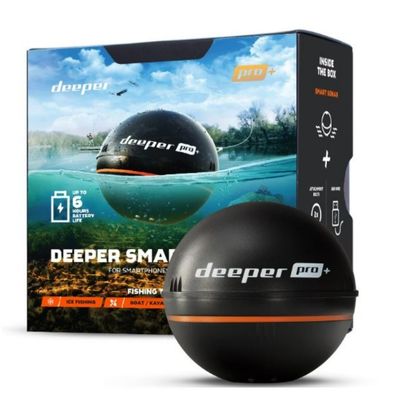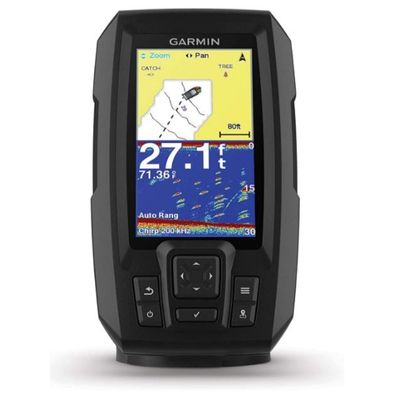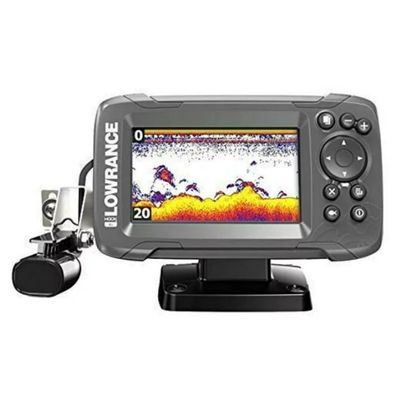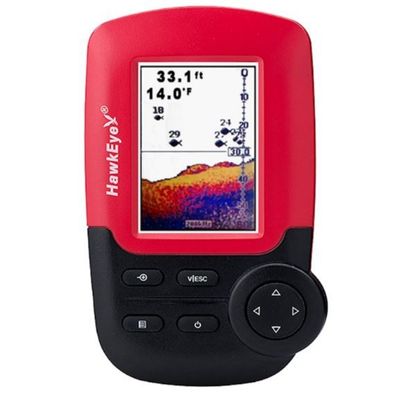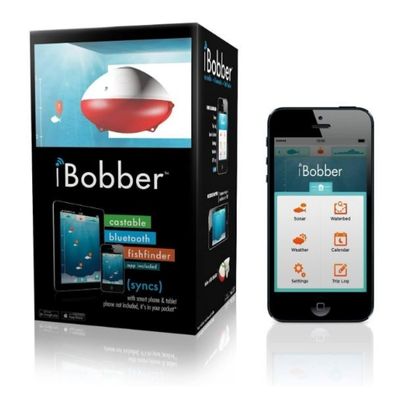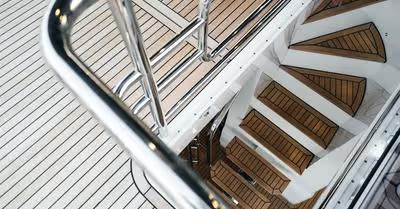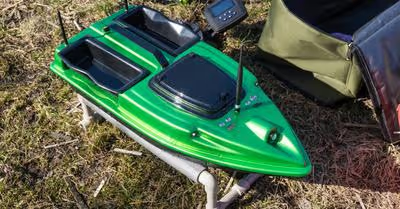
Key Takeaways
- The three best fish finders for small boats are the Deeper PRO+ Smart Fish Finder, Garmin Striker Plus 4, and Humminbird Helix 5 Series.
- We recommend a fish finder with a 3" to 4" display screen for small boat owners. This is easier to mount without taking up too much space.
- Remember to think about the screen size, display resolution, battery life, power, frequency, etc. when choosing between the best fish finders for small boats.
I’ve spent years on the water catching fish, and the best way to improve fishing efficiency on a small boat is with a reliable fish finder device.
The best fish finders for small boats are
- Deeper PRO+ Smart Fish Finder
- Garmin Striker Plus 4
- Humminbird Helix 5 Series
- Lowrance HOOK2-4x Bullet Skimmer
- Hawkeye Fishtrax 1C Handheld Fish Finder
- LUCKY Portable Fish Finder
- ReelSonar Wireless Smart Fish Finder
Finding the perfect device to match each individual's needs can be confusing. We struggled to find one that worked well and provided enough durability and battery life for our fishing trips. This is why we tested all the fish finders below and created this detailed guide to help others find the right fish finder and catch more fish.
7 Best Fish Finders For Small Boats
I love fishing from a small boat and wanted to up my game, but it took me some time to find the best fish finder. The traditional fishing trip is much better with one of these because they can detect underwater fish beneath and around the boat.
While these gadgets have a reputation for being bulky and expensive, I've located some portable fish finders and compact models in much smaller sizes and more affordable prices. They are easier to carry around and use on smaller boats too.
So for anybody looking to upgrade their fishing experience on small vessels, I've created this list just for you. Let's take a look at some of the top choices below.
1. Deeper PRO+ Smart Fish Finder
Deeper PRO+ Smart Fish Finder
The Deeper PRO+ Smart Fish Finder is the perfect choice for small boat owners like me because it is user-friendly. This is a good fish finder with excellent features.
This device uses advanced technology to quickly locate where fish are located within the area, significantly increasing the chances of success on the water. We also recommend adding the Deeper Smartphone Mount with your purchase.
So what should users expect with the Deeper PRO+? First, the built-in GPS can create bathymetric maps for users to scan maps quicker, pin critical locations, and look back at previous history.
The real-time data is also impressive. Users can get max speed because the two beam frequencies provide 15 scans per second. The range is top-notch, with a 330-foot radius and 260-foot scanning radius.
This fish finder is compatible with IOS and Android devices. It also includes a rechargeable battery with cloud compatibility to store all data. No internet is needed to use the features on this device.
Pros
- Works with and without WiFi
- Accurately identifies fish depth and type
- Casting range of 330 feet
- Lightweight with excellent portability
- Android and iOS compatibility
Cons
- Expensive price tag
- Casting can be a headache occasionally
2. Garmin Striker Plus 4
Garmin Striker Plus 4
I decided to try the Garmin Striker Plus 4 fish finder and was impressed with how well it worked. This fantastic device is perfect for small boats because of the dual-beam transducer, quickdraw mapping, and built-in GPS.
The built-in GPS receiver allows users to mark waypoints and navigate unfamiliar waters easily. The intuitive user interface makes setting up waypoints simple while enabling us to see our current position on the mapped display.
And if all that wasn't enough, there's even support for speed control functions such as trolling motor integration and depth contours tracking so we can get the most out of our fishing adventure.
I’d rank this as the most durable option too. It can handle inclement weather and fishing conditions. The 4.3” display is waterproof and fights off sunlight well, making it readable while on the water.
Pros
- Features advanced CHIRP sonar scanning technology
- Adjustable frequency range for extra accuracy
- Waypoint marking to easily track fish activity
- Trolling motor integration helps make navigation easier
Cons
- It does not include a unit cover
- Poor NMEA connectivity
3. Humminbird Helix 5 Series
Humminbird Helix 5 Series
The Humminbird Helix 5 Series is expensive but more advanced than most of the products in this guide. It provides a clear view underneath the boat and all around it because of the updated side imaging feature.
It comes with standard sonar technologies such as Down Imaging and Side Imaging Scanning, which allows us to look beneath the boat and find fish around us. One cool thing about this fish finder is the variety available. It’s available in multiple models and variations.
I also loved the 5-inch LED-backlit display. The widescreen view makes it much easier to access the Navionics map cards. It also provides coverage of over 21,000 bodies of water across the USA and Canada.
This touchscreen fish finder is one of the most advanced. It has the most accurate digital sonar technology, down imaging sonar, and mapping technology. We noticed amazing maximum depth readings too.
Pros
- Advanced LED backlight
- Excellent image and display resolution
- Scans larger areas with ease
- Intuitive and easy-to-use interface
Cons
- No chart plotting functionality
4. Lowrance HOOK2-4x Bullet Skimmer
Lowrance HOOK2-4x Bullet Skimmer
The Lowrance HOOK2-4x Bullet Skimmer is a game-changing fish finder that gives anglers the power of CHIRP Sonar technology and Autotuning capabilities to help them locate, identify and target fish easier than ever before.
This device features an impressive 4" color display screen that lets you see what's beneath the water clearly and easily. It also boasts a built-in GPS that allows users to track their boat’s speed, position, heading, and other data.
Users can expect comprehensive sonar coverage. This device has a high-frequency sonar transducer, giving highly detailed images of whatever lies beneath us in real time.
It’s also available in larger screen sizes between 5” and 12”. The autotuning sonar, full chart plotter, and GPS navigation make this one of the best fish finders. The 4” display model is portable and ideal for small boats.
I loved the wide-angle sonar cone on this device. It enhances our coverage and adds extra depth for fishing. It also provides a traditional 2D sonar view on small boats when needed.
Pros
- Inexpensive
- Excellent portability
- Available in various sizes
- Optimal settings for small boat fishing
Cons
- No advanced plotting or map features
5. Hawkeye Fishtrax 1C Handheld Fish Finder
Hawkeye Fishtrax 1C Handheld Fish Finder
The Hawkeye Fishtrax 1C Handheld Fish Finder is the perfect device for anglers looking to take their fishing game up a notch. This handheld fish finder is great for small boats on the water, as it packs many features into a lightweight and compact design.
The Fishtrax sonar technology can detect schools of fish swimming within 240 feet of the boat using sound waves. It also has a powerful zoom feature that allows users to hone in on specific areas to ensure we target the best spots for fishing success.
The display is crystal clear and easy to read, with adjustable sensitivity settings allowing us to adjust based on conditions like salinity or temperature. The dimensions of this device are 6" x 3" x 2". The 2” HD display is big enough for accurate readings on the water.
One cool feature is the Ice Mode Digital Flasher. This setting mode includes a jig depth reader for ice fishing. I’d consider this one of the most versatile multi-use fish finders.
Pros
- Lightweight & compact design
- Easy to use and set up
- User-friendly menu options make navigation simple
- The backlit LCD offers enhanced visibility in low-light conditions
Cons
- Lower sensitivity than other fish finders on the market
- Occasional lag times between send and receive signals
6. LUCKY Portable Fish Finder
LUCKY Portable Fish Finder
The LUCKY Portable Fish Finder is one of the top fish-finding tools for small boats, offering accurate dual beam sonar data that gives anglers a better picture of what’s below them in the water. It's also commonly used on docks and kayaks because of its convenience.
The device offers a high-definition LCD screen with vivid color displays and adjustable backlighting so we can see even during nighttime fishing trips. We can expect 26 feet of operating distance and 328 feet of water depth fish detection.
The built-in temperature sensor lets us take readings quickly, providing extra insight into what kind of environment may be most suited for catching certain fish species. This is also a rechargeable device with decent battery life.
This device also features wireless Bluetooth connectivity so users can link devices together for sharing data among multiple users. I love the portability this fish finder can offer too.
Pros
- Powerful 500W peak-to-peak power output
- Updated underwater contour display
- Wireless connection options with iOS and Android
- Works in various environments, including ice fishing
Cons
- The smaller 2.4-inch display screen is not as helpful as some larger options
7. ReelSonar Wireless Smart Fish Finder
ReelSonar Wireless Smart Fish Finder
The ReelSonar Wireless Smart Fish Finder is a unique and one of the best castable fish finders at this price. Users of this gadget can expect a depth range of 135 feet and 10 hours of battery life.
The traditional sonar signals will generate detailed visual images of the static and moving objects underwater. This includes depth-tagging the fish it locates and using color-coded signals to indicate which are closest to make fishing easier.
What makes this product so different is the castable iBobber included with the purchase. This small object gets cast into the water and floats are the area sending an alarm signal to the device to alert you when fish are close.
It’s durable and works in all weather conditions. It works well, and you can have great success catching fish using it, but It’s not the most advanced product, and the iBobber can be laggy at times.
Pros
- Portable and easy to use
- Accurate measurements of fish size and depth up to 135 feet
- Castable fish finder that works for kayak fishing too
- Detects fish in any water body
- Long battery life with rechargeable battery
Cons
- Reduced range and lack of advanced tracking features compared to premium models
What To Look For When Finding The Best Small Boat Fish Finder
When shopping for the best small boat fish finder, there are a few things to remember. The perfect fish finder can make fishing trips more productive and enjoyable, but it’s essential to understand what features will benefit your particular needs.
Here’s what to look for when finding the best small boat fish finder.
Power & Strength
The power output of the fish finder is a crucial factor to consider. While higher power outputs offer improved performance, they usually require larger transducers with more extensive cabling and additional battery drain.
For speedier operations, consider choosing dual beam technology that provides narrow range/high-resolution readings without sacrificing power output levels significantly. We need less power in shallow waters.
The general rule of thumb is that for 100 watts of power at 50 kHz, we can get accurate readings up to 400 feet.
Frequency
The frequency determines how accurately and deeply the device scans underwater. On smaller boats where space and weight are at a premium, choose a high-frequency model (120 kHz or more), as these require less power draw.
Higher frequencies also provide better resolution and sharper detail despite having more limited range capabilities than lower-frequency models (50kHz or below).
The water depth should be the deciding factor. For deep water, at least 140 kHz is required. For shallow waters 600 feet deep or less, a frequency over 160 kHz is suitable.
Screen Size
Screen size is tricky on these devices because the general thought is the bigger the screen, the better. But because we have a small boat, this is not the case.
Using a larger screen on a small boat will put the device at risk. It’s harder to mount and handle for small tasks. We can also expect to spend more money when opting for a larger screen.
Resolution
The display quality of your fish finder should be at the top of your list when evaluating potential models. A good display will show detailed images with minimal reflection. A murky image will not accurately represent what may or may not be below the surface.
Generally, industry experts recommend at least 240 x 160 pixels. However, I found this too low, and a 320 x 320 resolution provides a much better picture.
Mounting Compatibility
Next, think about the mounting requirements. This is one feature that makes a great fish finder because small boats have limited space.
The device should either be one of the best portable fish finder options or have an easy to install mount to use while on the water.
Side Imaging
Side imaging is a cool feature to help us get better readings of fish in the area. It scans the water horizontally on each side of the boat to locate fish.
While this can be useful, it’s not as good as down imaging. But in a small boat, side imaging is worth using because it casts a wider fishing area and does well to locate smaller fish.
Battery Life
Lastly, the battery life needs to be considered. This is especially important if the goal is to take this device on a long fishing trip. Some of the best options we’ve found can last 6-10 hours on a single charge.
What Is The Best Fish Finder Screen Size For Small Boats?
I have a few things to consider when selecting the best fish finder screen size for my small boat. First and foremost is portability. I want something light, compact, and easy to move around with me when necessary.
The second is visibility. I need the image on the screen to be clear enough to quickly identify what’s beneath the water's surface. Any GPS fish finder with a screen diameter between 2.5-5.0” is suitable for a small boat.
3" to 4" screens are best suited for smaller boats because they are cheaper but still have the necessary features to find fish. They’re also lighter than larger sizes, making them portable when you want or need to move them around.
How To Use A Fish Finder On A Small Boat
If you’re like me, you have a small boat and want to get the most out of it when it comes to fishing. One of the ways that I maximize my time on the water is by using a fish finder.
But if you’ve never used one before, trying to figure out how everything works can be overwhelming. Here are the steps to set it up and running correctly on a small boat.
Step One: Power Up The Gadget
First, we want to power up the device. It’s best to charge it to a full battery before spending a day on the water. Otherwise, expect it to die before the trip ends because many of these devices have a shorter battery life.
Step Two: Get Familiar With The Interface
After the device is running, I recommend learning about how it works. The interface changes with each device, so understanding how it works can save time.
Read the instructions. Learn about the basic functions. Try to find out a few shortcuts. The touch screen fish finder is usually easier to operate.
Step Three: Adjust The Settings
There are various settings options that need to be adjusted. Some of them include sensitivity, range, zoom, scanning, views, etc.
For starters, increase the screen brightness and sensitivity. Turn on auto-range too. These are beginner settings to get better readings for fish in the area.
Step Four: Mount The Device
Next, we have the option to mount the device on the boat. This usually makes fishing easier, and better protects the fish finder because we can use it hands-free now.
It's also vital that the device is mounted so that it does not interfere with other equipment on board or create an unsafe sailing experience due to excess weight distribution around the vessel's centerline.
Step Five: Read The Screen Correctly
Now we need to understand what the screen is showing us. One thing that confuses new fish finder users is the different colors. These indicate the hotter areas packed with fish. Typically, red means a large area of fish.
Another example is the shape. When the device finds a large fish, it will show an arch. Round shapes mean small schools of fish. Vertical means objects like rocks or debris are in the way.
Step Six: Catch Some Fish
The great thing about these devices is ease of use. They can be easily converted into a kayak fish finder with a few settings adjustments. After we have it set up and running correctly, it’s time to put it to work and catch some fish.
Do All Portable Fish Finders Come With GPS & Navigation?
Gone are the days of guessing where the best fishing spots are located. With the advent of modern technology, anglers now have an edge in locating fish with a fishfinder equipped with GPS & navigation capabilities.
But this comes at an increased cost. Many of the budget options won’t have either features, which can be problematic and make it harder to locate fish with the device in hand.
It’s also worth noting that a majority of fish finders do not have any type of navigation system. Unless there is a chartplotter feature, the GPS is only used to pinpoint a location.



